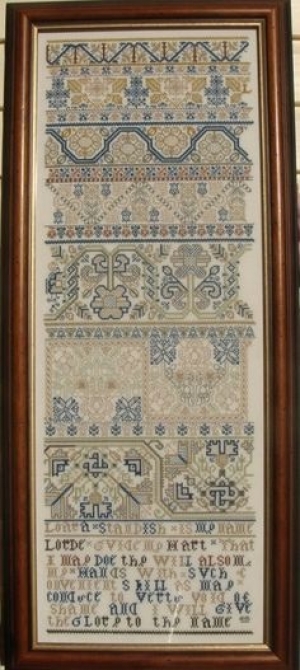The sampler is decorated with bands of stylised flowers (roses and carnations), acorns and intertwined ‘s’ designs.
Stitched at the bottom is: "Loara Standish is my name Lorde guide my hart that I may doe thy will also My hands with such Convenient skill as may Conduce to virtue void of Shame and I will give The glory to thy name"
Loara Standish (born after 1627 and died before 1655) lived in the Plymouth Colony, Massachusetts, and was one of seven children of Myles and Barbara Standish. Her parents are famous for being among the original ‘Pilgrims', a group of 102 mainly English Puritans and Separatists who sailed in 1620 from Plymouth (UK) to Massachusetts (USA) aboard an English ship called the Mayflower, after having lived in Leiden, The Netherlands, for a number of years. Myles Standish, who also had lived in Leiden, eventually became the military commander of the Plymouth colony, a function he held until his death in 1656. He is the main character, although highly romanticised, of Longfellow's narrative poem, The Courtship of Myles Standish (1858).
Loara Standish is believed to have died young, but exactly when is unknown. She lies buried, as far as can be ascertained, in the Myles Standish Burial Ground, Duxbury, Massachusetts, USA. The sampler was kept in her brother Josiah’s family until it was donated to the Pilgrim Hall Museum in Plymouth, Massachusetts in 1844.
See also the Sarah Stone's sampler; The Mayflower, Loara Standish, and the City of Leiden.
Sources:
- HUBER, Carol, et al. (2011). With Needle and Brush: Schoolgirl Embroidery from the Connecticut River Valley, 1740-1840, Old Lyme: Florence Griswold Museum.
- PARMAL, Pamela (2012). Women’s Work: Embroidery in Colonial Boston, Boston: Museum of Fine Arts Publications.
- www.americanhistory.si.edu/collections/object-groups/american-samplers (retrieved 30 March 2016)
- http://www.pilgrimhallmuseum.org/pdf/Loara_Standish_Sampler.pdf (retrieved 30 March 2016)
GVE and SA

